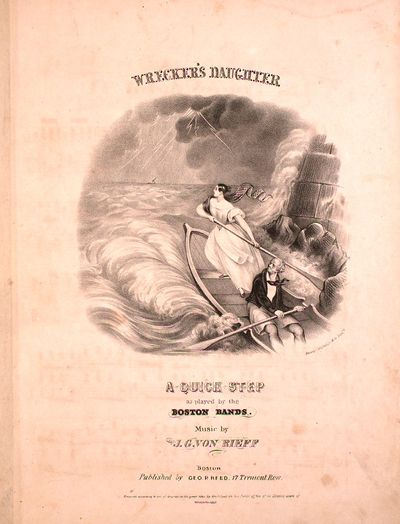Annotation:Wrecker's Daughter (1): Difference between revisions
m (Text replacement - "Century Gothic" to "sans-serif") |
No edit summary |
||
| Line 1: | Line 1: | ||
---------- | |||
{{TuneAnnotation | |||
|f_tune_annotation_title= https://tunearch.org/wiki/Annotation:Wrecker's_Daughter > | |||
|f_annotation='''WRECKER'S DAUGHTER.''' American, Quickstep (2/4 time). D Major (Bayard, Sweet): C Major (Howe/Accordeon). Standard tuning (fiddle). ABC (Bayard): AABBC (Sweet): AABBCC (Howe). The melody was originally German, composed by J.G Von Rieff (1771-1842), adapted by Conrad Fay. The melody was widely known as a fife march. | |||
---- | |||
---- | |||
'''WRECKER'S DAUGHTER.''' American, Quickstep (2/4 time). D Major. Standard tuning (fiddle). AABBCC. The melody was originally German, composed by J.G Von Rieff (1771-1842), adapted by Conrad Fay. | |||
[[File:wreckers.jpg|400px|thumb|right|]] | [[File:wreckers.jpg|400px|thumb|right|]] | ||
The piece commemorates a 23 year woman, Grace Darling [https://en.wikipedia.org/wiki/Grace_Darling], who rescued nine people from the wreck of SS Forfarshire, which sank near the Farne Islands off the coast of Northumberland in 1831. It was was the inspiration for musical pieces, prose works and stage plays, as well as songs, and was popular with mid-19th century brass bands (particularly as a solo by keyed bugle players). Sheridan Knowles wrote a play called '''The Wreckers's Daughter''', staged at Drury Lane in 1836. | The piece commemorates a 23 year woman, Grace Darling [https://en.wikipedia.org/wiki/Grace_Darling], who rescued nine people from the wreck of SS Forfarshire, which sank near the Farne Islands off the coast of Northumberland in 1831. It was was the inspiration for musical pieces, prose works and stage plays, as well as songs, and was popular with mid-19th century brass bands (particularly as a solo by keyed bugle players). Sheridan Knowles wrote a play called '''The Wreckers's Daughter''', staged at Drury Lane in 1836. | ||
<br> | <br> | ||
<br> | <br> | ||
|f_source_for_notated_version= John Meighen (elderly fiddler from Greene County, Pa., 1930's) [Bayard]. | |||
= | |f_printed_sources=Bayard ('''Dance to the Fiddle'''), 1981; No. 293, p. 249. Hopkins ('''American Veteran Fifer'''), 1927; No. 121. Howe ('''Complete Preceptor for the Accordeon'''), 1843; p. 27. Howe ('''School for the Violin'''), 1851; p. 30. Oliver Ditson ('''The Boston Collection of Instrumental Music'''), c. 1850; p. 100. Sweet ('''Fifer’s Delight'''), 1965; p. 55. ''''The Company of Fifers and Drummers, '76''', 1974; p. 17. | ||
|f_recorded_sources= | |||
|f_see_also_listing= | |||
}} | |||
------------- | |||
Revision as of 14:39, 3 June 2021
X:1 T:Wrecker's Daughter [1] M:2/4 L:1/8 R:Quick-Step B:Oliver Ditson – The Boston Collection of Instrumental Music (c. 1850, p. 100) Z:AK/Fiddler’s Companion K:D A/A/A/z/ A/A/A/z/|FA d2|dcBA|B/B/B/z/ B/B/B/z/|Bd g2| gfed|c/c/c/z/ c/c/c/z/|c/c/c/z/ c/c/c/z/|Ac/e/ a2|Ac/e/ a2| fedf|edce|d/d/d/z/ d/d/d/z/|d2 z2::eefe|ccdc| BBf>e|c>^G A/B/c/d/|eefe| ccdc|BBfe|A z a2:| |:(F2 A)d|(F2 A)d|(G2 B)d|(F2 A)d|(E2G)B|(A2 d)f| e^g/g/ gg|az a2|(F2 A)d|(F2 A)d|(G2B)d| (F2 A)d|(E2G)B|(A2d)f|eA/A/ Bc|d3 z!D.C.!:|]
WRECKER'S DAUGHTER. American, Quickstep (2/4 time). D Major (Bayard, Sweet): C Major (Howe/Accordeon). Standard tuning (fiddle). ABC (Bayard): AABBC (Sweet): AABBCC (Howe). The melody was originally German, composed by J.G Von Rieff (1771-1842), adapted by Conrad Fay. The melody was widely known as a fife march.

The piece commemorates a 23 year woman, Grace Darling [1], who rescued nine people from the wreck of SS Forfarshire, which sank near the Farne Islands off the coast of Northumberland in 1831. It was was the inspiration for musical pieces, prose works and stage plays, as well as songs, and was popular with mid-19th century brass bands (particularly as a solo by keyed bugle players). Sheridan Knowles wrote a play called The Wreckers's Daughter, staged at Drury Lane in 1836.

